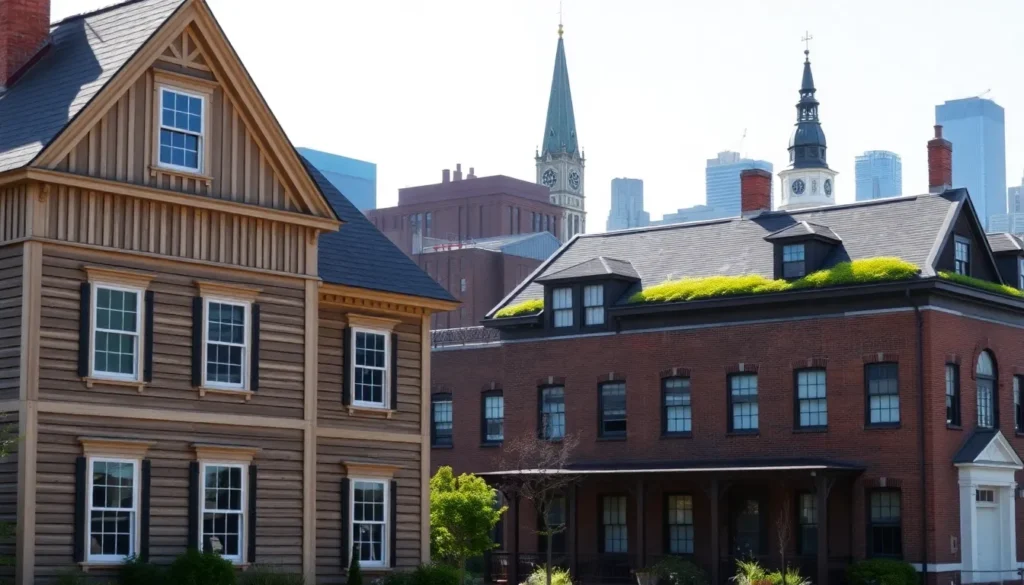Table of Contents
ToggleArchitecture isn’t just about walls and roofs; it’s the art of shaping our lives. Imagine walking through a city where every building tells a story, each design reflecting the dreams and aspirations of its creators. From the towering skyscrapers that scrape the sky to the cozy homes that cradle families, architecture influences how we live, work, and play.
The Evolution Of Architecture
Architecture has evolved significantly over centuries, reflecting cultural values and technological advancements. This evolution highlights the relationship between society and its built environment.
Ancient Civilizations
Ancient civilizations played a crucial role in establishing architectural principles. Egyptians constructed monumental pyramids, showcasing their beliefs in the afterlife. Greeks introduced columns and symmetry, influencing public buildings such as temples. Romans advanced engineering with arches and concrete, enabling the construction of large structures like the Colosseum. Each of these elements contributed to a distinctive style that mirrored the civilization’s identity and aspirations.
Modern Innovations
Modern innovations in architecture focus on sustainability and technology. Skyscrapers dominate urban skylines, utilizing steel and glass for efficiency. Green architecture promotes energy conservation through materials like solar panels and rainwater harvesting systems. Digital tools streamline design processes, allowing for precision and creativity. Such innovations shape contemporary living spaces while addressing environmental challenges, creating a harmonious balance between functionality and aesthetics.
Key Architectural Styles

Architecture showcases various distinct styles, each reflecting cultural significance and technological advancements. Two prominent styles are Gothic architecture and Modernism.
Gothic Architecture
Gothic architecture flourished during the High and Late Middle Ages, roughly from the 12th to the 16th centuries. Known for its soaring structures, this style incorporates pointed arches, ribbed vaults, and flying buttresses. Cathedrals like Notre-Dame and Chartres Cathedral embody the intricate designs and verticality characteristic of this era. Ornate sculptures and stained glass windows reflect religious themes and narratives, enriching the spiritual experience. Architectural innovations improved both aesthetics and structural integrity, allowing for taller and more light-filled interiors. These developments marked a significant departure from Romanesque styles, showcasing the era’s artistic and engineering prowess.
Modernism
Modernism emerged in the late 19th and early 20th centuries as a response to traditional architecture. It emphasizes simplicity, functionality, and the use of new materials, like steel and glass. Iconic structures, such as the Bauhaus Building and the Villa Savoye, illustrate the principles of this movement. Clean lines and a minimalist approach define many modernist designs, breaking away from ornate decorations. Architects like Le Corbusier and Ludwig Mies van der Rohe championed these ideals, influencing urban landscapes worldwide. This period redefined living spaces, focusing on form following function and promoting efficiency while minimizing environmental impact.
Influential Architects
Architecture reflects the vision of its creators. Influential architects shape our built environment, leaving lasting legacies.
Frank Lloyd Wright
Frank Lloyd Wright pioneered organic architecture, harmonizing structures with their natural surroundings. His famous designs, such as Fallingwater and the Guggenheim Museum, exemplify this philosophy. Each building integrates seamlessly with the landscape, demonstrating a respect for nature. Wright introduced cantilevered roofs and open floor plans, revolutionizing spatial concepts. His innovative use of materials and craftsmanship became hallmarks of his style, influencing countless architects. The Prairie School movement, which he founded, emphasized horizontal lines reflecting the American landscape’s flatness. Notably, his vision for urban spaces has inspired sustainable architectural practices today.
Zaha Hadid
Zaha Hadid, known for her bold and dynamic designs, redefined contemporary architecture. Her work features fluid forms and organic shapes, creating a dialogue between structures and their environments. The Heydar Aliyev Center and the Guangzhou Opera House are testaments to her visionary approach. Each design pushes boundaries, showcasing her mastery of modern technology and materials. Hadid’s use of parametric design principles enabled the creation of complex geometries previously unimaginable. As the first woman to win the Pritzker Architecture Prize, she broke barriers and became an icon in the field. Her legacy encourages adaptability and innovation in architectural design.
Sustainable Architecture
Sustainable architecture emphasizes the creation of buildings that minimize environmental impact while maximizing efficiency. It reflects a growing awareness of ecological concerns in architectural design.
Eco-Friendly Materials
Eco-friendly materials play a crucial role in sustainable architecture. Recycled steel, reclaimed wood, and bamboo are popular choices that reduce waste and energy consumption. Many architects choose low-VOC paints and finishes, which improve indoor air quality. Also, using sustainable insulation materials, such as cellulose or sheep’s wool, enhances energy efficiency. Natural stone and earth-friendly concrete contribute to durability and aesthetics, further aligning construction with eco-conscious practices. These materials not only promote sustainability but also support the health and well-being of occupants.
Energy Efficiency
Energy efficiency is a cornerstone of sustainable architecture. High-performance windows and proper insulation significantly reduce heat loss, positively impacting energy consumption. Additionally, incorporating solar panels offers renewable energy solutions, allowing buildings to generate their own power. Smart technologies, such as programmable thermostats and energy-efficient lighting, further optimize energy use. Moreover, passive design strategies, including strategic orientation and natural ventilation, harness the environment to regulate indoor climate. Prioritizing energy efficiency helps create comfortable spaces while lessening the carbon footprint of buildings.
Architecture is more than just the design of buildings; it’s a reflection of culture, innovation, and human aspiration. As societies evolve, so do their architectural expressions, showcasing a blend of tradition and modernity. The emphasis on sustainability in contemporary design highlights a growing commitment to the environment and the well-being of future generations.
Innovative architects continue to push boundaries, creating spaces that inspire and connect people to their surroundings. By understanding the stories behind architectural styles and the impact of notable figures, one can appreciate the profound role architecture plays in shaping everyday life. Ultimately, architecture remains a dynamic art form that influences how individuals interact with their environments.


